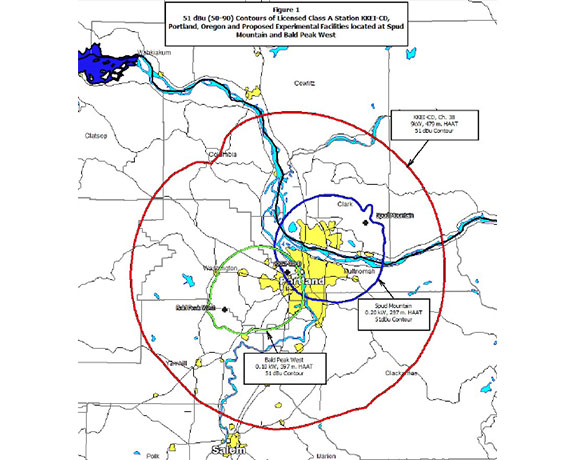FCC Ok's WatchTV ATSC 3.0 DTS Experiment

Click on the Image to Enlarge
PORTLAND, ORE.
—A low-power broadcaster in the Pacific Northwest plans to fire up ATSC 3.0 broadcasts on multiple frequencies over a distributed transmission system, or DTS. WatchTV of Portland had requested an experimental license from the Federal Communications Commission to allow its Portland-area Class A low-power stations to be used for a ATSC 3.0 DTS. The request was granted Tuesday, Feb. 14. WatchTV has six months to run its experimental broadcasts with the caveat that they don’t cause interference.
“We... conclude that the public interest would be served by the grant of this request since the information obtained from the experiment may be valuable to the commission’s broadband initiative. However, we caution you that an experimental facility is secondary and may be summarily terminated if the operation causes interference to any other broadcast facility, ” the commission said in its
.
Specifically, WatchTV requested it be allowed to use its KKEI-CD facility, broadcasting on Ch.38, to transmit a ATSC 3.0 signal over a DTS configured of two more sites. ATSC 3.0 broadcasts also will be transmitted on frequencies occupied by three more WatchTV stations that share the KKEI-CD transmitter site—KORS-CD at Ch. 16; KOXI-CD at Ch. 20; and KORK-CD at Ch. 35. The primary signals of each of these stations will be carried on a fifth WatchTV licensee, KOXO-CD, transmitting on Ch. 41.
The professional video industry's #1 source for news, trends and product and tech information. Sign up below.
“All spurious emissions on all channels will be confined within the limits applicable to ATSC 1.0 transmissions,”
stated. “Because ATSC 3.0 is an OFDM‐based system, the potential for interference to other stations transmitting ATSC 1.0 facilities will be less than the potential from the existing licensed ATSC 1.0 facilities of the four stations. The emission mask at all three transmitter sites will be stringent.”
Facilities at the two DTS sites, Spud Mountain and Bald Peak West, (
Fig. 1, above right
) were designed to ensure that their 51 dBu signal contour remained within the contour of the KKEI-CD originating facility, WatchTV said.
The broadcaster said its objectives included learning more about ATSC 3.0 signal propagation characteristics “in a geographic area with much more uneven terrain than exists in the Washington‐ Baltimore area, where Sinclair Broadcast Group, Inc. conducted its recent experimental operations.” Additionally, WatchTV said it would explore delivery of multiple data services alongside various TV formats, including Ultra HD, and that it wanted to see if multifrequency network broadcasting would increase the data capacity of ATSC 3.0.
“WTV’s experiment will use four channels. WTV’s program will be the first experiment of which it is aware in which spectrum will be available to test spreading data across multiple TV channels while each channel is also transmitting single‐channel video content,” the WatchTV application stated.
WatchTV further said it wished to “explore the benefits of distributed antenna systems by transmitting simultaneously from three transmitter sites initially, with the possibility that a request will be filed at a later date to add more sites,” and to “explore the robustness and capabilities of a multi‐frequency system to deliver video and other content to mobile receivers”
Greg Herman, WatchTV president and CEO, told Mike Gravino of the LPTV Spectrum Rights Coalition he was grateful to the FCC staff for their “rapid assessment and approval of our experimental application.
“As we have contended for many years, television broadcasters in the United States are in dire need of a new and technologically advanced television broadcasting system.
“The world has passed us by in the last decade, and left us in a place where broadcast television spectrum is no longer relevant in the daily lives of average Americans. This must change, and we believe that ATSC 3.0, next-generation TV is an essential step in this evolution.
“Further, we are excited and encouraged to demonstrate the essential role Class A and LPTV broadcasters and their spectrum can play in the new ATSC 3.0 ecosystem. We want to be first and we want to be the best we can be!”
For more
TV Technology
coverage, see our ATSC 3.0 silo. Also see....
Feb. 17, 2011
“
WatchTV Multicast Broadcasting Proposal Nixed by FCC
”
WatchTV had an idea for making more efficient use of the spectrum authorized for its low-power TV stations.
